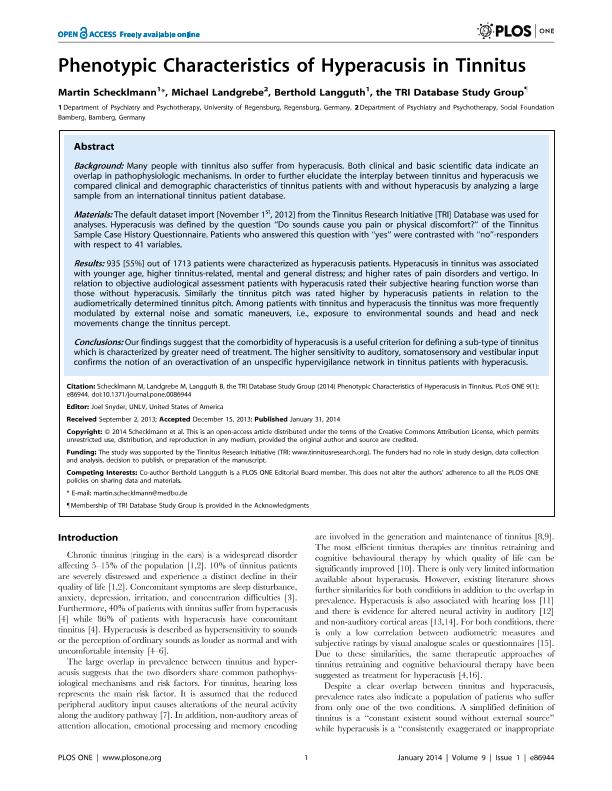Artículo
Phenotypic Characteristics of Hyperacusis in Tinnitus
Schecklmann, Martin; Landgraebe, Michael; Langguth, Berthold; Elgoyhen, Ana Belen ; Tinnitus Research Initiative Database Group
; Tinnitus Research Initiative Database Group
 ; Tinnitus Research Initiative Database Group
; Tinnitus Research Initiative Database Group
Fecha de publicación:
02/2014
Editorial:
Public Library of Science
Revista:
Plos One
ISSN:
1932-6203
Idioma:
Inglés
Tipo de recurso:
Artículo publicado
Clasificación temática:
Resumen
Background: Many people with tinnitus also suffer from hyperacusis. Both clinical and basic scientific data indicate an overlap in pathophysiologic mechanisms. In order to further elucidate the interplay between tinnitus and hyperacusis we compared clinical and demographic characteristics of tinnitus patients with and without hyperacusis by analyzing a large sample from an international tinnitus patient database.
Materials: The default dataset import [November 1st, 2012] from the Tinnitus Research Initiative [TRI] Database was used for analyses. Hyperacusis was defined by the question “Do sounds cause you pain or physical discomfort?” of the Tinnitus Sample Case History Questionnaire. Patients who answered this question with “yes” were contrasted with “no”-responders with respect to 41 variables.
Results: 935 [55%] out of 1713 patients were characterized as hyperacusis patients. Hyperacusis in tinnitus was associated with younger age, higher tinnitus-related, mental and general distress; and higher rates of pain disorders and vertigo. In relation to objective audiological assessment patients with hyperacusis rated their subjective hearing function worse than those without hyperacusis. Similarly the tinnitus pitch was rated higher by hyperacusis patients in relation to the audiometrically determined tinnitus pitch. Among patients with tinnitus and hyperacusis the tinnitus was more frequently modulated by external noise and somatic maneuvers, i.e., exposure to environmental sounds and head and neck movements change the tinnitus percept.
Conclusions: Our findings suggest that the comorbidity of hyperacusis is a useful criterion for defining a sub-type of tinnitus which is characterized by greater need of treatment. The higher sensitivity to auditory, somatosensory and vestibular input confirms the notion of an overactivation of an unspecific hypervigilance network in tinnitus patients with hyperacusis.
Palabras clave:
Tinnitus
,
Hypercusis
Archivos asociados
Licencia
Identificadores
Colecciones
Articulos(INGEBI)
Articulos de INST.DE INVEST.EN ING.GENETICA Y BIOL.MOLECULAR "DR. HECTOR N TORRES"
Articulos de INST.DE INVEST.EN ING.GENETICA Y BIOL.MOLECULAR "DR. HECTOR N TORRES"
Citación
Schecklmann, Martin; Landgraebe, Michael; Langguth, Berthold; Elgoyhen, Ana Belen; Tinnitus Research Initiative Database Group; Phenotypic Characteristics of Hyperacusis in Tinnitus; Public Library of Science; Plos One; 9; 1; 2-2014; e86944-e86944
Compartir
Altmétricas



